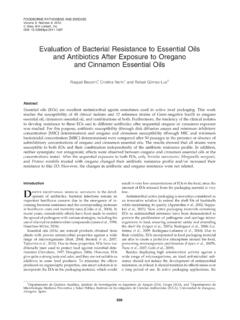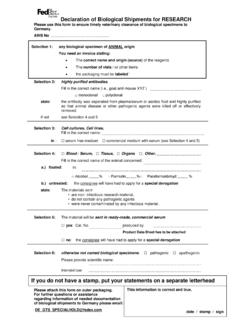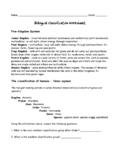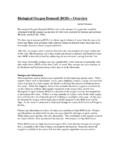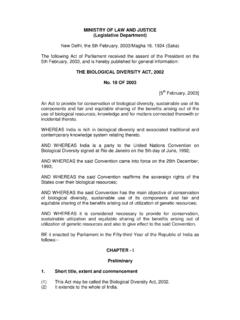Transcription of Biological activities of Lavender essential oil
1 REVIEW ARTICLEB iological activities of Lavender essential OilH. M. A. Cavanagh and J. M. Wilkinson*School of Biomedical Sciences, Charles Sturt University, Wagga Wagga, NSW 2678, AustraliaEssential oils distilled from members of the genusLavandulahave been used both cosmetically and thera-peutically for centuries with the most commonly used species beingL. angustifolia, L. latifolia, L. stoechasandL. x intermedia. Although there is considerable anecdotal information about the Biological activity ofthese oils much of this has not been substantiated by scientific or clinical evidence. Among the claimsmade for Lavender oil are that is it antibacterial, antifungal, carminative (smooth muscle relaxing), seda-tive, antidepressive and effective for burns and insect bites. In this review we detail the current state ofknowledge about the effect of Lavender oils on psychological and physiological parameters and its use asan antimicrobial agent.
2 Although the data are still inconclusive and often controversial, there does seemto be both scientific and clinical data that support the traditional uses of Lavender . However, methodo-logical and oil identification problems have severely hampered the evaluation of the therapeutic signifi-cance of much of the research onLavandulaspp. These issues need to be resolved before we have a truepicture of the Biological activities of Lavender essential oil. Copyright#2002 John Wiley & Sons, : Lavender ; Lavandula; antimicrobial; of us have grown up with the scent of Lavender inour homes and this essential oil continues to be as populartoday as it has been down the centuries past. Documentedevidence for the use of Lavender as a therapeutic agentcan be traced back to the ancient Romans and Greeks andthe continuing popularity and commercial value oflavender was recently confirmed when it was named Herb of the Year 1999 by the Herb Growing andMarketing Network in the United States of America(Evelegh, 1996; Anonymous, 1999).
3 Lavenders (Lavan-dulaspp.) belong to the family Labiatae (Lamiacae) andhave been used either dried or as an essential oil forcenturies for a variety of therapeutic and cosmeticpurposes. Lavender essential oil is produced, usually bysteam distillation, from both the flower heads and foliage,but the chemical composition differs greatly, with thesweeter and most aromatic oil being derived from theflowers (McGimpsey and Porter, 1999). The oil istraditionally believed to be antibacterial, antifungal,carminative (smooth muscle relaxing), sedative, anti-depressive and effective for burns and insect bites(Grieve 1931; Gattefosse, 1937). Today, the pure oil ismost often used in aromatherapy or incorporated intosoaps and other products as a pleasant fragrance or as anantimicrobial agent. Yet despite its popularity, and thelong tradition of use, it is only recently that science-basedinvestigations into the Biological activity of the variousLavandulaspecies have been undertaken to any greatextent.
4 In this paper we review current researchinvestigating the Biological activities of Lavender oiland highlight areas that require further investigation. Asconfusion over the common names for Lavender speciesoccurs throughout both the lay and the scientific pressbotanical names are used, where known, in this fall into four main categories:Lavandulalatifolia, a Mediterranean grass-like Lavender ;Lavandulaangustifolia, a stockier plant with a fuller flower,commonly known as English Lavender (formerly knownasL. veraorL. officinalis);Lavandula stoechas, whichhas butterfly-like bracts on top of the flowers and issometimes known as French Lavender ; andLavandula xintermedia, which is a sterile cross betweenL. latifoliaandL. angustifolia. The various lavenders have similarethnobotanical properties and major chemical constitu-ents, however, there are some differences in the reportedtherapeutic uses for different species.
5 For example mostlavenders are believed to have carminative actions traditionally used for headache,L. latifoliaasan abortifacient andL. angustifoliaas a diuretic(Agricultural Research Service, 2000). Many of theactivities attributed to Lavender oils, however, have notbeen substantiated in the scientific literature. Forexample, although Lavender is often listed as a substanceto be avoided in pregnancy (Fetrow and Avila, 1999;Langer, 2000) there is no evidence to support this claimwhich seems to be based on the belief that Lavender oil isan emmenagogue and hence able to promote and regulatemenstruation. It would seem logical that if a substancehas the capacity to bring on menses that, shouldfertilization have occurred then the embryo would belost and the substance would be, by default, anabortifacient. However, there is no scientific evidenceto suggest that Lavender is in fact an emmenagogue, nor isPHYTOTHERAPY RESEARCHP hytother.
6 , 301 308 (2002)Published online in Wiley InterScience ( ).DOI: #2002 John Wiley & Sons, Ltd.* Correspondence to: J. M. Wilkinson, School of Biomedical Sciences,Charles Sturt University, Locked Bag 588, Wagga Wagga, NSW 2678,Australia. Phone: 612 69334019; Fax: 612 6933 : 13 September 2001 Revised 26 February 2002 Accepted 20 March 2002there any consensus as to which Lavender species hasthese properties or whether these properties refer toingested or cutaneously absorbed COMPOSITION OF LAVENDERESSENTIAL OILSE ssential oils are complex mixtures of many differentaromatic compounds. The oil composition is determinedmainly by the genetic make-up of each cultivar, althoughit can also be influenced by the distillation process(McGimpsey and Porter, 1999). There are a number ofmethods used for the analysis of oils from standard analytic techniques of gaschromatography with mass spectrometry (GC/MS) orinfra-red spectroscopy (GC/IRFT).
7 As a consequence theoil profile of lavenders used commercially are wellknown (Ristorcelliet al., 1998) and InternationalStandard specifications (ISO) have been published forsome, but not all, lavenders (McGimpsey and Porter,1999). The main constituents of Lavender oil are linalool,linalyl acetate, 1,8-cineole,b-ocimene (usually bothcis-andtrans-), terpinen-4-ol and camphor. Each of theseconstituents can vary significantly in oils derived fromdifferent cultivars with the relative levels of each beingthe main determinant of market value, application traditional analysis ofLavandulaoils, however,has mainly focused on analysis of the oil derived fromflower heads. More recently, focus has turned towardsanalysis of the flower aroma , defined as the analysis ofthe head space volatile components rather than the wholeliquid oil. Several researchers have produced aromaprofiles for the various lavenders, which can varysignificantly from the whole oil profile (Weisenfeld,1999; Anet al.)
8 , 2001). Aroma analysis of those plantswith typical scents has demonstrated that oils derivedfromL. stoechasandL. lanatahave high camphor levelswhileL. angustifolia, L. dentataandL. pinnataare low(<2%) in camphor. These low camphor plants tend alsoto have higher levels of terpenes ( )and sesquiterpenes ( caryophyllene). This is notunexpected given the profile of the essential oil and thetraditional use of these plants. For example,L. angusti-foliais used in the perfumery and cosmetic industrieswhile the high camphor plants are used as insectrepellents and for other non-perfumery uses. Furthercomparison of the oil and aroma profiles (volatilecomponent) has shown significant differences betweenthe two profiles particularly with respect to the level oflinalool, linalyl acetate (both higher in oil) and varioussesquiterpenes (higher in the volatiles) (Weisenfeld,1999).
9 This is an especially important point whenconsidering the bioactivity of these oils in aromatherapysituations, where the aroma or volatiles are likely toplay a significant EFFECTS OF LAVENDERA romatherapy is thought to be therapeutically effectivedue to both the psychological effect of the odour and thephysiological effects of the inhaled volatile compounds,where the latter effects are believed to act via the limbicsystem, particularly the amygdala and the exact cellular mechanism of action is unknownone author has suggested that Lavender (based on studiesofL. angustifolia) may have a similar action to thebenzodiazepines and to enhance the effects of gamma-aminobutyric acid in the amygdala (Tisserand, 1988).Others have found that linalool inhibits acetylcholinerelease and alters ion channel function at the neuromus-cular junction (Reet al., 2000). Linalool and linalylacetate are rapidly absorbed through the skin after topicalapplication with massage, reaching peak plasma levelsafter approximately 19 min (Jageret al.)
10 , 1992) and arethought to be able to cause central nervous systemdepression. Linalyl acetate has narcotic actions andlinalool acts as a sedative (Tisserand and Balacs, 1999;Reet al., 2000). These calming actions of Lavender maybe the origin of the traditional use of a Lavender herbpillow to help induce sleep. The high camphor content insome lavenders ( stoechas), however, is thought toprecipitate convulsions when used at high concentrations(Tisserand and Balacs, 1999).A number of studies have also investigated the effectof either Lavender , or its major constituent linalool, onbrain activity or specific receptor populations (Yamadaetal., 1994; Elisabetskyet al., 1995; Elisabetskyet al.,1999). However, the relevance of these studies is limitedas they were performed in laboratory rodents and do notreflect the normal doses or exposure routes to lavenderessential oil in oil today is used predominantly in aro-matherapy or massage, and many benefits are claimed foruse in this way.





